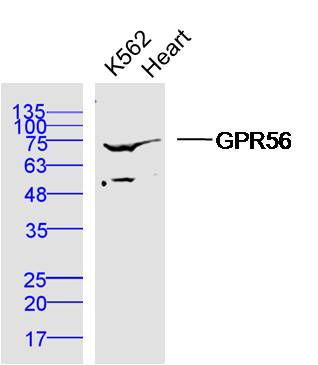产品货号 : mlR11848
英文名称 : GPR56
中文名称 : 蛋白偶联受体56抗体
别 名 : BFPP; DKFZp781L1398; EGF TM7 like; G protein coupled receptor 56; GPR 56 ; Polymicrogyria bilateral frontoparietal; TM7LN4; TM7XN1; TM7XN1 protein; GPR56_HUMAN.
研究领域 : 肿瘤 细胞生物 神经生物学 细胞膜受体 G蛋白偶联受体 G蛋白信号
抗体来源 : Rabbit
克隆类型 : Polyclonal
交叉反应 : Human, Mouse, Rat, Dog, Pig, Cow, Horse, Rabbit,
产品应用 : WB=1:500-2000 ELISA=1:500-1000
not yet tested in other applications.
optimal dilutions/concentrations should be determined by the end user.
分 子 量 : 78kDa
细胞定位 : 细胞膜
性 状 : Lyophilized or Liquid
浓 度 : 1mg/ml
免 疫 原 : KLH conjugated synthetic peptide derived from human GPR56:275-350/693 <Extracellular>
亚 型 : IgG
纯化方法 : affinity purified by Protein A
储 存 液 : 0.01M TBS(pH7.4) with 1% BSA, 0.03% Proclin300 and 50% Glycerol.
保存条件 : Store at -20 °C for one year. Avoid repeated freeze/thaw cycles. The lyophilized antibody is stable at room temperature for at least one month and for greater than a year when kept at -20°C. When reconstituted in sterile pH 7.4 0.01M PBS or diluent of antibody the antibody is stable for at least two weeks at 2-4 °C.
PubMed : PubMed
产品介绍 : G protein-coupled receptors (GPRs or GPCRs), also known as seven transmembrane receptors, heptahelical receptors, or 7TM receptors, are members of the largest protein family and play a role in many different stimulus-response pathways. G-protein coupled receptors mediate extracellular signals into intracellular signals (G-protein activation). They respond to a great variety of signaling molecules, including hormones, neurotransmitters and other proteins and peptides. GPR proteins are integral seven-pass membrane proteins with some conserved amino acid regions. G-protein coupled receptor 56 (GPR56), also designated TM7XN1 protein, contains one GPS domain. GPR56 plays an important role in cell-cell interactions and is widely expressed, with highest levels detected in brain, heart and thyroid gland. Defects in the gene encoding for GPR56 can cause bilateral frontoparietal polymicrogyria (BFPP) which is characterized by disorganized cortical lamination.
Function:
GPR56 contains 7 transmembrane domains as well as a mucin-like domain and cysteine box in the N-terminal region. Its expression is widely distributed and the highest levels can be found in brain, thyroid gland and heart. It is also expressed in a great number of tumor cells. Results show that mutations in GPR56 cause a human brain cortical malformation called bilateral frontoparietal polymicrogyria (BFPP); data suggest that GPR56 signaling plays an essential role in regional development of human cerebral cortex.
Subcellular Location:
Cell membrane. Multi-pass membrane protein.
Tissue Specificity:
Widely distributed with highest levels found in thyroid gland, brain and heart. Expressed in a great number of tumor cells.
Post-translational modifications:
The endogenous protein is proteolytically cleaved into 2 subunits, an extracellular subunit and a seven-transmembrane subunit.
DISEASE:
Defects in GPR56 are the cause of bilateral frontoparietal polymicrogyria (BFPP) [MIM:606854]. BFPP is characterized by disorganized cortical lamination that is most severe in frontal cortex.
Similarity:
Belongs to the G-protein coupled receptor 2 family. LN-TM7 subfamily.
Contains 1 GPS domain.
SWISS:
Q9Y653
Gene ID:
9289
Important Note:
This product as supplied is intended for research use only, not for use in human, therapeutic or diagnostic applications.
产品图片












